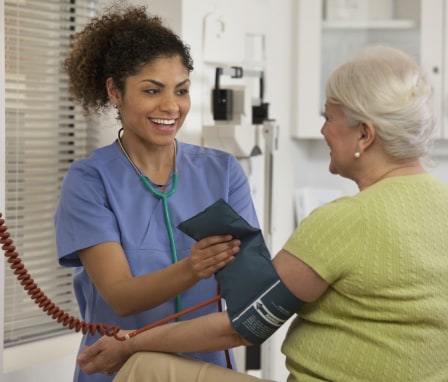Completing a Health Assessment in Nursing
 Credit: Getty Images
Credit: Getty ImagesIt’s a common occurrence in any health facility: nurses walk into a room and make a head-to-toe assessment of the patient. This is a critical part of creating a healthcare plan, but what does a nursing health assessment actually entail?
Keep reading to learn more about health assessments in nursing and why they matter.
What is a Comprehensive Health Assessment in Nursing?
Nurses conduct health assessments in clinics, physician offices, hospitals, and emergency rooms. How a nurse performs an assessment depends on the case, namely the person’s age and condition.
All nursing health assessments include paperwork and physical exams. Nurses systematically work on the patient from head to toe, beginning with the least invasive procedure.
Health assessments in nursing begin the moment a nurse walks into the room. Nurses note nonsocial cues. They use their sight and smell to look for symptoms. From there, nurses take a patient’s vital signs — temperature, heart rate, and blood pressure.
Advanced practical nurses (APRNs) may conduct an annual physical exam, while registered nurses (RNs) complete problem-focused exams for patients admitted into hospitals or urgent care departments.
Nursing health assessments help health professionals diagnose diseases and illnesses. Assessments also inform preventative care plans. Through nursing health assessments, nurses can provide guidance and gain patient trust.
Beginning a Nursing Health Assessment
Nursing programs teach students how to conduct nursing health assessments, but nurses often fine tune their skills on the job. Each nurse develops their own style to build patient relationships.
1 Build Patient Rapport
Patients often face social, emotional, and/or cultural barriers in accessing healthcare. Nurses have the power to calm patients — especially from historically excluded communities — who feel anxious or worried about their health.
A nurse’s mannerisms and the questions a nurse asks can build trust. For instance, when nurses start an assessment, they can develop a relationship through an introduction and by explaining what they are about to do. At this point, nurses can also assess a patient’s preference for the physical exam and make an effort to address any fears.
2 Family and Past Health History
On an initial patient visit, nurses ask about family and past medical histories. This information can help shape nursing care plans. During this process, nurses learn of any chronic illnesses, past surgeries, medications taken, sexual activity, and social habits such as smoking or drug use.
During this process, nurses can put patients at ease and build rapport by showing empathy and allowing patients to answer in their own time.
3 General Status and Vital Signs
After a nurse records a patient’s health history, they move to the physical exam. The first part of the physical exam entails the general status check-up. Nurses take vital signs, checking a patient’s heart rate, blood pressure, temperature, and respiratory rate.
Conducting the Physical Exam
Nurses can assess a patient at first sight by taking into account the patient’s posture, emotional state, speech, and hygiene. After nurses take a patient’s vital signs, the physical exam begins. Nurses examine the patient methodically from head to toe, beginning with the head, ears, eyes, nose, and throat (HEENT).
 Head
Head
Palpating the head and scalp to check the shape, size, and symmetry can provide information about underlying issues or trauma such as concussions. Nurses also examine facial expressions for drooping or asymmetry, which can help in the diagnosis of a stroke or other conditions that cause facial paralysis. The head assessment also includes:
- Moving hair in sections to look for injuries
- Observing the scalp to look for lice, dandruff, or lesions
- Inspecting the head for masses or tenderness
- Checking that facial movements are symmetrical by asking patients to move their eyebrows or smile
 Ears
Ears
Inspecting the ears using an otoscope can provide insight on hearing loss, vertigo, or tinnitus. Nurses can also identify any cancers or lesions on the outer ear. Ear assessments may also involve:
- Using an otoscope to look for discharge or skin discoloration
- Hitting a tuning fork to test for hearing loss
- Investigating cerumen (earwax) impaction as a cause of hearing loss
- Asking patients about any medications they take
- Checking the inner ear for perforations or swelling in the membrane
 Eyes
Eyes
Testing the eyes can provide information about a patients’ brain function. A pupil examination can offer signs about head injury. Nurse uses an ophthalmoscope to inspect the external eye functionality. They also:
- Visually inspect the eyes for excessive discharge, redness, or growths
- Record eyesight aids patient uses, including contacts or eyeglasses
- Check the pupils for PERRLA — Pupils: Equal, Round, Reactive to Light, and Accommodation (transitioning focus between close and far objects)
 Nose
Nose
A nose assessment begins by inspecting the exterior for discoloration, symmetry, swelling, malformations, or lesions. For instance, a nurse may note if they find a lesion or dark spot. Using a penlight or the light from an otoscope, nurses examine the nasal cavities for discoloration, discharge, and symmetry. They may continue assessing the nose by:
- Using their thumb to palpate one sinus at a time to identify pain or tenderness
- Closing one nostril at a time to check for normal airflow
- Checking to make sure that the nose is the same color as the patient’s face
 Throat
Throat
A throat inspection can lead to early detection of oral cancer and potentially save someone’s life. Assessments can also help nurses detect strep throat or dysphagia.
Nurses inspect the throat for abnormalities. Throat examinations involve checking the teeth and gums, tongue, uvula, and tonsils, inner lining of the lips and cheeks, and the soft and hard palates. Nurses also:
- Use a tongue depressor to inspect the cheeks for abnormalities such as lesions
- Examine the top and underside of the tongue for discoloration
- Visually inspect the lips for lesions
- Check the coloration of the lips and gums
- Note fouls smells or a fruity scent that could be a sign of ketoacidosis
 Neck
Neck
Nurses inspect the neck to check for jugular venous distention, range of motion, and to see if patients can easily shrug with resistance. A neck examination begins with nurses looking at the location of the trachea to make sure it’s center, and then includes:
- Palpating the sides of the neck to check for swollen lymph nodes
- Checking the neck for tenderness and lumps
- Inspecting thyroid size and shape
- Examining the back of the neck for signs of spinal column injuries
- Looking at the neck for lesions and lumps
 Respiratory
Respiratory
Nurses need to know the basics of the respiratory system to recognize signs of respiratory deterioration. Checking the lungs for tenderness and masses, and listening to the lung sounds can provide clues about underlying health issues. Respiratory assessments also include:
- Making visual assessments of a patient’s respiratory rate
- Asking patients if they experience shortness of breath or have a cough
- Placing their hand to the patient’s back to evaluate symmetrical chest rise.
- Using the stethoscope to listen for full inspiration and expiration
- Inspecting the size, shape, and symmetry of the chest
 Cardiac
Cardiac
It takes a stethoscope and keen observation skills to perform a cardiac assessment, which provides crucial data about cardiovascular system function. Nurses use palpation and visual cues to look for the quality of cardiac blood flow. The exam often includes:
- Using a stethoscope to auscultate the five points of the heart: Erb’s point and the aortic, pulmonic, tricuspid, and mitral valves
- Palpating the chest wall, looking for vibratory sensations
- Listening for normal heart rates and rhythms
 Abdomen
Abdomen
From a supine position, nurses can begin an abdomen examination. This includes auscultation, percussion, and palpation. Nurses may perform abdomen assessments on patients with percutaneous endoscopic gastrostomy feeding tubes or with ostomy pouches. Otherwise routine abdomen assessments include:
- Asking questions about any pain in bowel and urination movements
- Inspecting the abdomen to look at contours and pulsations
- Looking for masses or wounds
- Using the stethoscope to listen to bowel sounds at all four quadrants
- Listening to vascular sounds using the stethoscope’s bell
 Pulses
Pulses
Pulse assessments tell nurses about a patient’s health status. Nurses look for pulses in different areas of the body — the neck, arms, legs, and feet — depending on the case. During CPR, nurses may check the carotid artery for a pulse to determine if the brain and head are receiving blood flow. Where a nurse looks for a pulse also depends on the patient’s age. Nurses can:
- Check the temporal artery for a pulse
- Find the apical pulse point
- Assess the blood pressure by checking the brachial artery
- Palpate the radial, femoral, posterior tibial, and dorsalis pedi pulse points
 Extremities
Extremities
An essential part of the head-to-toe includes examining the extremities: the arms, hands, legs, and feet. Nurses look for lesions, redness, swelling, injuries, and — in the case of hospitalized patients — they may check the entrypoint of an intravenous line.
A proper assessment can help doctors diagnose gout, diabetes, or deep vein thrombosis. Nurses during an assessment may:
- Palpate the radial artery and joints — the elbows, wrists, and hands — to check skin temperature
- Ask the patient to move and flex their arms and legs against resistance
- Check the color of the legs and toes
- Test extremities for a range of motion
- Inspect the strength and musculature of extremities
 Neurological
Neurological
An examination of coordination, balance, and sensory response can provide information about neurological trauma and prevent long-term damage. In the emergency room and hospital neuro units, patients receive neurological assessments. Nurses also perform neuro exams in other departments. The exams include:
- Using the Romberg test to assess balance
- Checking the gait, including posture
- Examining olfactory and optic nerves
- Checking a patient’s level of consciousness by using the Glasgow Coma Scale
- Assessing orientation and memory by asking a patient routine questions
Frequently Asked Questions About Health Assessments
 What is a complete health assessment?
What is a complete health assessment?
A complete nursing health assessment requires a health professional to examine a patient in a systematic fashion, from head to toe. Nurses rely on self-reported symptoms, visual observation, reported health histories, and a physical medical examination to make a health assessment. This data then informs the nursing care plan.
 When are health assessments performed in nursing?
When are health assessments performed in nursing?
A nursing health assessment helps nurses and other health professionals in a variety of settings to understand a patient’s mental and physical health. In the emergency room, a patient may receive a neurological assessment to test their level of consciousness.
Patients also receive health assessments during their annual physical checkups. At outpatient clinics or long-term care facilities, nurses use health assessments to identify trauma or injury, or to treat disease and illnesses.
 Why are nursing health assessments important?
Why are nursing health assessments important?
A proper nursing health assessment can lead to early intervention, which saves lives. Nurses also use health assessments to start conversations about social or cultural barriers that patients face in assessing healthcare.
A verbal and physical nursing health assessment helps nurses to gather information about a person’s symptoms, pain, and mobility level. A problem-focused assessment can also direct analysis to specific areas: cardiac, extremities, respiratory, or throat.
 What are the four techniques used in physical nursing assessments?
What are the four techniques used in physical nursing assessments?
Nurses have a set of skills and tools that they rely on to conduct a nursing health assessment. Health assessments include observation and inspection, palpation, percussion, and auscultation. Nurses perform these techniques sequentially, except during abdominal assessments.


